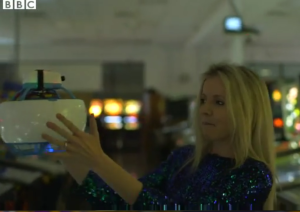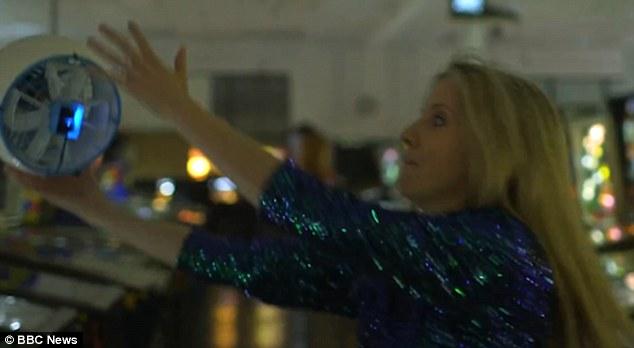 It wasn’t the best of moments for BBC reporter Jen Copestake. On the scene at CES 2016, Copestake was reporting on the Fleye, an innovative drone that has been introduced by a Belgian startup via a currently-running Kickstarter campaign. Described as the “world’s safest drone,” the Fleye is unique because of its ball-shaped design, which encloses the spinning propeller blade that keeps it aloft. According to the Kickstarter, the drone is about the same size, shape and weight as a soccer ball, and just as safe.
It wasn’t the best of moments for BBC reporter Jen Copestake. On the scene at CES 2016, Copestake was reporting on the Fleye, an innovative drone that has been introduced by a Belgian startup via a currently-running Kickstarter campaign. Described as the “world’s safest drone,” the Fleye is unique because of its ball-shaped design, which encloses the spinning propeller blade that keeps it aloft. According to the Kickstarter, the drone is about the same size, shape and weight as a soccer ball, and just as safe.
It was the Fleye’s safety that Copestake was describing to her audience when the incident happened. The drone floated over to her, buzzing cheerily, and she reached out for it, describing the foam-enclosed sphere that enables humans to safely interact with it. Safely for whom, though, appears to be up for debate. Humans, yes. The drone itself, however, didn’t fare so well in its encounter with Copestake, whose tentative grasp on the floating ball sent it spiraling out of control and crashing to the ground, where it broke into two pieces.
Luckily, the prototype of the Fleye was mostly 3D printed, so it can be easily repaired. The wounded drone was taken to CES triage, where it bravely allowed itself to be patched up with some tape and glue until it can be fully restored with a 3D printer. It was then released for a second meeting with Copestake, who managed to hold onto it this time, although its buzzing seemed to have taken on an angrier tone than before. According to Copestake, however, the incident was proof of how harmless the Fleye is.
“This did have the benefit though of demonstrating the drone’s safe design and enclosed propeller, which I wasn’t afraid was going to hurt me,” she said.
 Her wary approach to their first meeting suggested otherwise; however, I can’t say a buzzing, floating soccer ball zooming towards my head would have made me feel particularly at ease at first, either, even if it is about as adorable as a Star Wars droid. While the prototype was 3D printed, the final drone will be injection molded, which is supposed to make it sturdier. The Kickstarter describes the Fleye as robust enough to withstand bumping into things without damage; it doesn’t say anything about crash landings, but perhaps Copestake served as an unintentional beta tester by finding its weakness.
Her wary approach to their first meeting suggested otherwise; however, I can’t say a buzzing, floating soccer ball zooming towards my head would have made me feel particularly at ease at first, either, even if it is about as adorable as a Star Wars droid. While the prototype was 3D printed, the final drone will be injection molded, which is supposed to make it sturdier. The Kickstarter describes the Fleye as robust enough to withstand bumping into things without damage; it doesn’t say anything about crash landings, but perhaps Copestake served as an unintentional beta tester by finding its weakness.
While the Fleye’s pride may have been damaged by the incident, its reputation doesn’t appear to have suffered at all. With a week left in the Kickstarter campaign, the project has already received nearly $100,000 more than its fundraising goal. It will go into full production shortly after the end of the campaign, and will continue to undergo rigorous testing and development before it begins shipping in September 2016. One of the backing rewards is a 3D printed ornamental mini-Fleye. There’s no word on whether Copestake or the BBC plan to order one of the finished drones at this time.
Subscribe to Our Email Newsletter
Stay up-to-date on all the latest news from the 3D printing industry and receive information and offers from third party vendors.
You May Also Like
GREENFILL3D 3D Prints Sustainable Interior Solutions for Stretch Ceilings
Polish startup GREENFILL3D has previously produced sustainable in-store displays, plant markers, and lamps using sustainable materials and desktop 3D printers. I appreciate GREENFILL3D for its use of low-cost material extrusion...
3D Printing News Unpeeled: A $3000 SLS System, Construction Subsidies and Parameters
The Housing Affordability Crisis is one of Canadian President Trudeau’s biggest issues. Now the government has made subsidies available, including scaling new technologies, 3D printed housing and libraries of reapproved...
3D Printing News Briefs, April 6, 2024: Depowdering, Cybertruck Door Handles, & More
In today’s 3D Printing News Briefs, ioTech’s digital manufacturing CLAD technology is opening up opportunities for microelectronics and additive manufacturing. Hexagon and Raytheon Technologies commercially released the Simufact Additive Process...
“Bundled Light” Enables High Quality Plastic 3D Printing from LEAM
Naturally, we expect current 3D printing methods to continuously improve, but it continues to do so in the most surprising ways. The latest development comes from LEAM, a startup spun...































